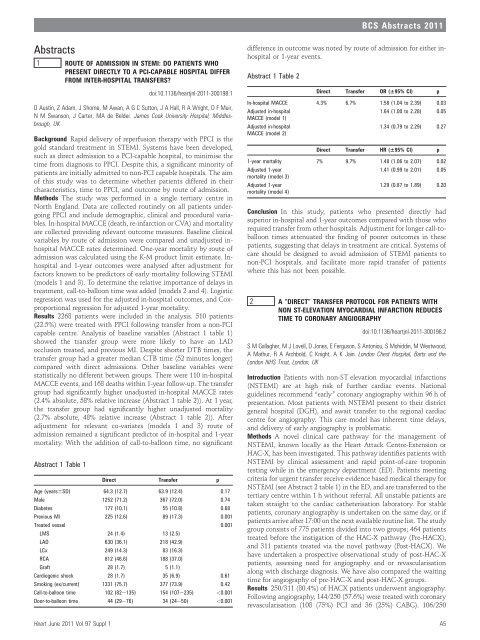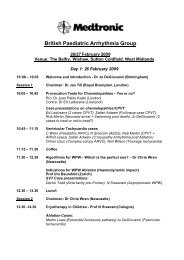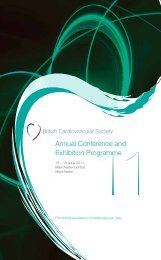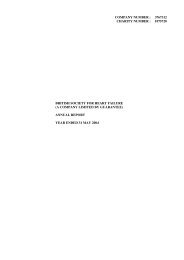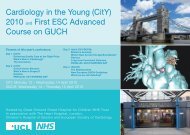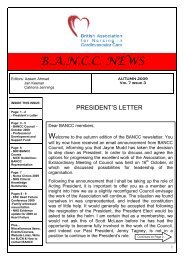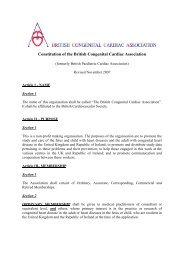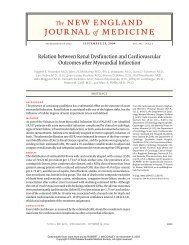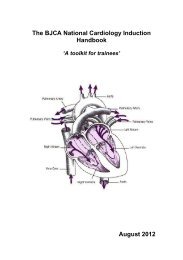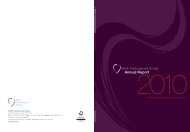Full Supplement - British Cardiovascular Society
Full Supplement - British Cardiovascular Society
Full Supplement - British Cardiovascular Society
You also want an ePaper? Increase the reach of your titles
YUMPU automatically turns print PDFs into web optimized ePapers that Google loves.
BCS Abstracts 2011<br />
Abstracts<br />
1 ROUTE OF ADMISSION IN STEMI: DO PATIENTS WHO<br />
PRESENT DIRECTLY TO A PCI-CAPABLE HOSPITAL DIFFER<br />
FROM INTER-HOSPITAL TRANSFERS?<br />
doi:10.1136/heartjnl-2011-300198.1<br />
D Austin, Z Adam, J Shome, M Awan, A G C Sutton, J A Hall, R A Wright, D F Muir,<br />
N M Swanson, J Carter, MA de Belder. James Cook University Hospital, Middlesbrough,<br />
UK<br />
Background Rapid delivery of reperfusion therapy with PPCI is the<br />
gold standard treatment in STEMI. Systems have been developed,<br />
such as direct admission to a PCI-capable hospital, to minimise the<br />
time from diagnosis to PPCI. Despite this, a significant minority of<br />
patients are initially admitted to non-PCI capable hospitals. The aim<br />
of this study was to determine whether patients differed in their<br />
characteristics, time to PPCI, and outcome by route of admission.<br />
Methods The study was performed in a single tertiary centre in<br />
North England. Data are collected routinely on all patients undergoing<br />
PPCI and include demographic, clinical and procedural variables.<br />
In-hospital MACCE (death, re-infarction or CVA) and mortality<br />
are collected providing relevant outcome measures. Baseline clinical<br />
variables by route of admission were compared and unadjusted inhospital<br />
MACCE rates determined. One-year mortality by route of<br />
admission was calculated using the K-M product limit estimate. Inhospital<br />
and 1-year outcomes were analysed after adjustment for<br />
factors known to be predictors of early mortality following STEMI<br />
(models 1 and 3). To determine the relative importance of delays in<br />
treatment, call-to-balloon time was added (models 2 and 4). Logistic<br />
regression was used for the adjusted in-hospital outcomes, and Coxproportional<br />
regression for adjusted 1-year mortality.<br />
Results 2268 patients were included in the analysis. 510 patients<br />
(22.5%) were treated with PPCI following transfer from a non-PCI<br />
capable centre. Analysis of baseline variables (Abstract 1 table 1)<br />
showed the transfer group were more likely to have an LAD<br />
occlusion treated, and previous MI. Despite shorter DTB times, the<br />
transfer group had a greater median CTB time (52 minutes longer)<br />
compared with direct admissions. Other baseline variables were<br />
statistically no different between groups. There were 110 in-hospital<br />
MACCE events, and 168 deaths within 1-year follow-up. The transfer<br />
group had significantly higher unadjusted in-hospital MACCE rates<br />
(2.4% absolute, 58% relative increase (Abstract 1 table 2)). At 1 year,<br />
the transfer group had significantly higher unadjusted mortality<br />
(2.7% absolute, 48% relative increase (Abstract 1 table 2)). After<br />
adjustment for relevant co-variates (models 1 and 3) route of<br />
admission remained a significant predictor of in-hospital and 1-year<br />
mortality. With the addition of call-to-balloon time, no significant<br />
Abstract 1 Table 1<br />
Direct Transfer p<br />
Age (years6SD) 64.3 (12.7) 63.9 (12.4) 0.17<br />
Male 1252 (71.2) 367 (72.0) 0.74<br />
Diabetes 177 (10.1) 55 (10.8) 0.68<br />
Previous MI 225 (12.6) 89 (17.3) 0.001<br />
Treated vessel 0.001<br />
LMS 24 (1.4) 13 (2.5)<br />
LAD 630 (36.1) 218 (42.9)<br />
LCx 249 (14.3) 83 (16.3)<br />
RCA 812 (46.6) 188 (37.0)<br />
Graft 28 (1.7) 5 (1.1)<br />
Cardiogenic shock 28 (1.7) 35 (6.9) 0.61<br />
Smoking (ex/current) 1331 (75.7) 377 (73.9) 0.42<br />
Call-to-balloon time 102 (82e135) 154 (107e235)


